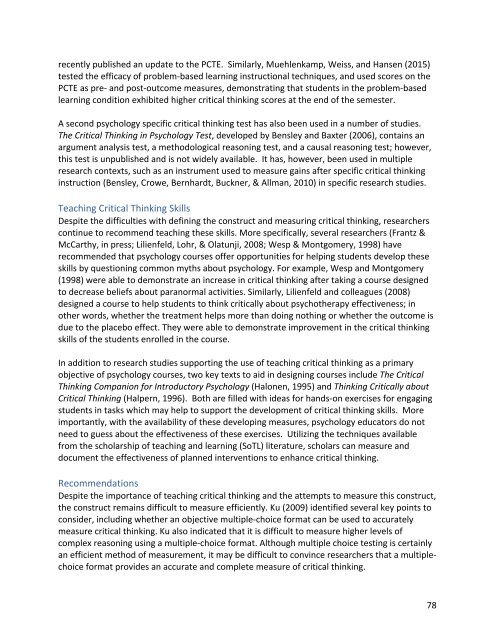A COMPENDIUM OF SCALES for use in the SCHOLARSHIP OF TEACHING AND LEARNING
compscalesstl
compscalesstl
You also want an ePaper? Increase the reach of your titles
YUMPU automatically turns print PDFs into web optimized ePapers that Google loves.
ecently published an update to <strong>the</strong> PCTE. Similarly, Muehlenkamp, Weiss, and Hansen (2015)<br />
tested <strong>the</strong> efficacy of problem-based learn<strong>in</strong>g <strong>in</strong>structional techniques, and <strong>use</strong>d scores on <strong>the</strong><br />
PCTE as pre- and post-outcome measures, demonstrat<strong>in</strong>g that students <strong>in</strong> <strong>the</strong> problem-based<br />
learn<strong>in</strong>g condition exhibited higher critical th<strong>in</strong>k<strong>in</strong>g scores at <strong>the</strong> end of <strong>the</strong> semester.<br />
A second psychology specific critical th<strong>in</strong>k<strong>in</strong>g test has also been <strong>use</strong>d <strong>in</strong> a number of studies.<br />
The Critical Th<strong>in</strong>k<strong>in</strong>g <strong>in</strong> Psychology Test, developed by Bensley and Baxter (2006), conta<strong>in</strong>s an<br />
argument analysis test, a methodological reason<strong>in</strong>g test, and a causal reason<strong>in</strong>g test; however,<br />
this test is unpublished and is not widely available. It has, however, been <strong>use</strong>d <strong>in</strong> multiple<br />
research contexts, such as an <strong>in</strong>strument <strong>use</strong>d to measure ga<strong>in</strong>s after specific critical th<strong>in</strong>k<strong>in</strong>g<br />
<strong>in</strong>struction (Bensley, Crowe, Bernhardt, Buckner, & Allman, 2010) <strong>in</strong> specific research studies.<br />
Teach<strong>in</strong>g Critical Th<strong>in</strong>k<strong>in</strong>g Skills<br />
Despite <strong>the</strong> difficulties with def<strong>in</strong><strong>in</strong>g <strong>the</strong> construct and measur<strong>in</strong>g critical th<strong>in</strong>k<strong>in</strong>g, researchers<br />
cont<strong>in</strong>ue to recommend teach<strong>in</strong>g <strong>the</strong>se skills. More specifically, several researchers (Frantz &<br />
McCarthy, <strong>in</strong> press; Lilienfeld, Lohr, & Olatunji, 2008; Wesp & Montgomery, 1998) have<br />
recommended that psychology courses offer opportunities <strong>for</strong> help<strong>in</strong>g students develop <strong>the</strong>se<br />
skills by question<strong>in</strong>g common myths about psychology. For example, Wesp and Montgomery<br />
(1998) were able to demonstrate an <strong>in</strong>crease <strong>in</strong> critical th<strong>in</strong>k<strong>in</strong>g after tak<strong>in</strong>g a course designed<br />
to decrease beliefs about paranormal activities. Similarly, Lilienfeld and colleagues (2008)<br />
designed a course to help students to th<strong>in</strong>k critically about psycho<strong>the</strong>rapy effectiveness; <strong>in</strong><br />
o<strong>the</strong>r words, whe<strong>the</strong>r <strong>the</strong> treatment helps more than do<strong>in</strong>g noth<strong>in</strong>g or whe<strong>the</strong>r <strong>the</strong> outcome is<br />
due to <strong>the</strong> placebo effect. They were able to demonstrate improvement <strong>in</strong> <strong>the</strong> critical th<strong>in</strong>k<strong>in</strong>g<br />
skills of <strong>the</strong> students enrolled <strong>in</strong> <strong>the</strong> course.<br />
In addition to research studies support<strong>in</strong>g <strong>the</strong> <strong>use</strong> of teach<strong>in</strong>g critical th<strong>in</strong>k<strong>in</strong>g as a primary<br />
objective of psychology courses, two key texts to aid <strong>in</strong> design<strong>in</strong>g courses <strong>in</strong>clude The Critical<br />
Th<strong>in</strong>k<strong>in</strong>g Companion <strong>for</strong> Introductory Psychology (Halonen, 1995) and Th<strong>in</strong>k<strong>in</strong>g Critically about<br />
Critical Th<strong>in</strong>k<strong>in</strong>g (Halpern, 1996). Both are filled with ideas <strong>for</strong> hands-on exercises <strong>for</strong> engag<strong>in</strong>g<br />
students <strong>in</strong> tasks which may help to support <strong>the</strong> development of critical th<strong>in</strong>k<strong>in</strong>g skills. More<br />
importantly, with <strong>the</strong> availability of <strong>the</strong>se develop<strong>in</strong>g measures, psychology educators do not<br />
need to guess about <strong>the</strong> effectiveness of <strong>the</strong>se exercises. Utiliz<strong>in</strong>g <strong>the</strong> techniques available<br />
from <strong>the</strong> scholarship of teach<strong>in</strong>g and learn<strong>in</strong>g (SoTL) literature, scholars can measure and<br />
document <strong>the</strong> effectiveness of planned <strong>in</strong>terventions to enhance critical th<strong>in</strong>k<strong>in</strong>g.<br />
Recommendations<br />
Despite <strong>the</strong> importance of teach<strong>in</strong>g critical th<strong>in</strong>k<strong>in</strong>g and <strong>the</strong> attempts to measure this construct,<br />
<strong>the</strong> construct rema<strong>in</strong>s difficult to measure efficiently. Ku (2009) identified several key po<strong>in</strong>ts to<br />
consider, <strong>in</strong>clud<strong>in</strong>g whe<strong>the</strong>r an objective multiple-choice <strong>for</strong>mat can be <strong>use</strong>d to accurately<br />
measure critical th<strong>in</strong>k<strong>in</strong>g. Ku also <strong>in</strong>dicated that it is difficult to measure higher levels of<br />
complex reason<strong>in</strong>g us<strong>in</strong>g a multiple-choice <strong>for</strong>mat. Although multiple choice test<strong>in</strong>g is certa<strong>in</strong>ly<br />
an efficient method of measurement, it may be difficult to conv<strong>in</strong>ce researchers that a multiplechoice<br />
<strong>for</strong>mat provides an accurate and complete measure of critical th<strong>in</strong>k<strong>in</strong>g.<br />
78


